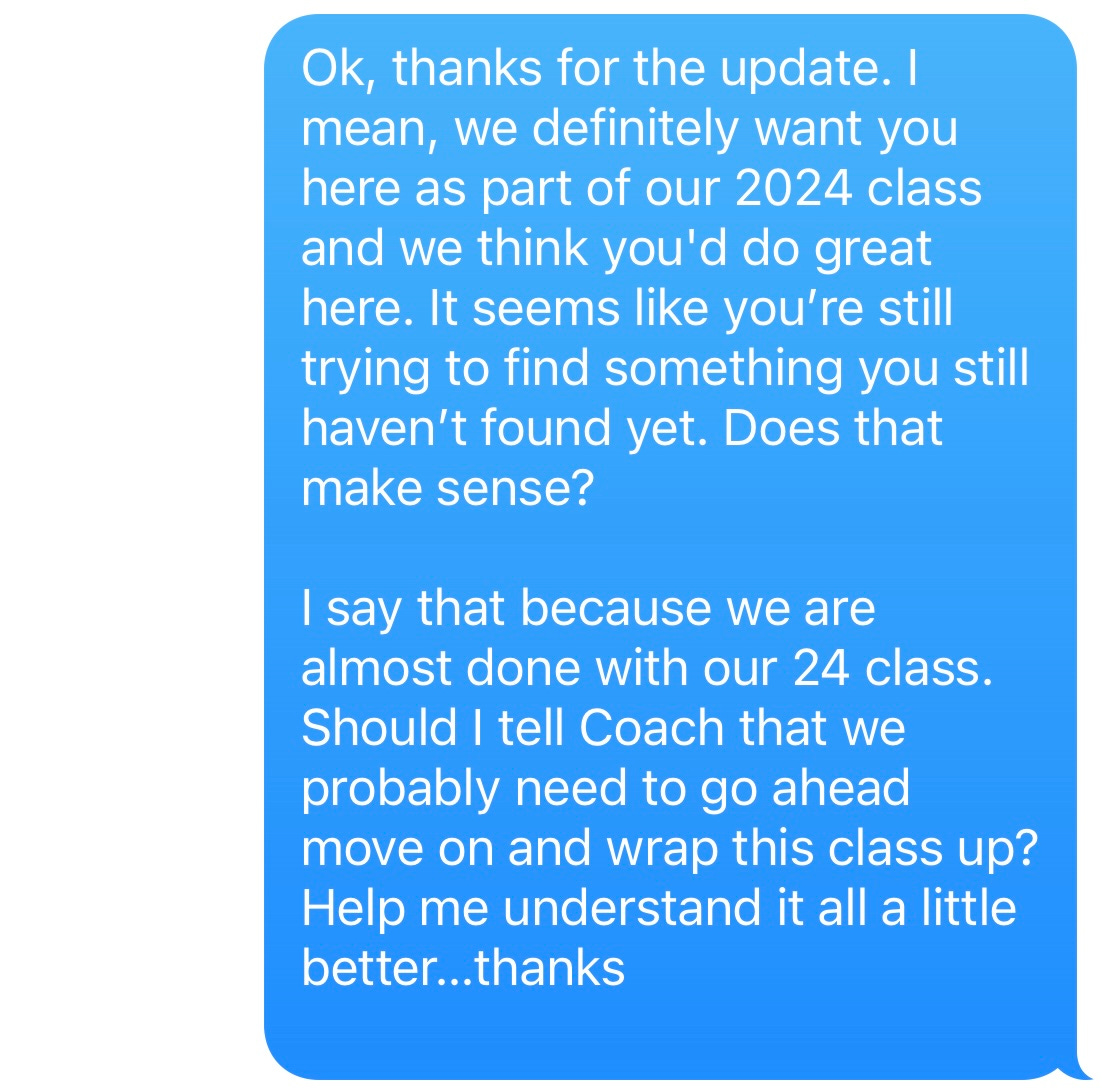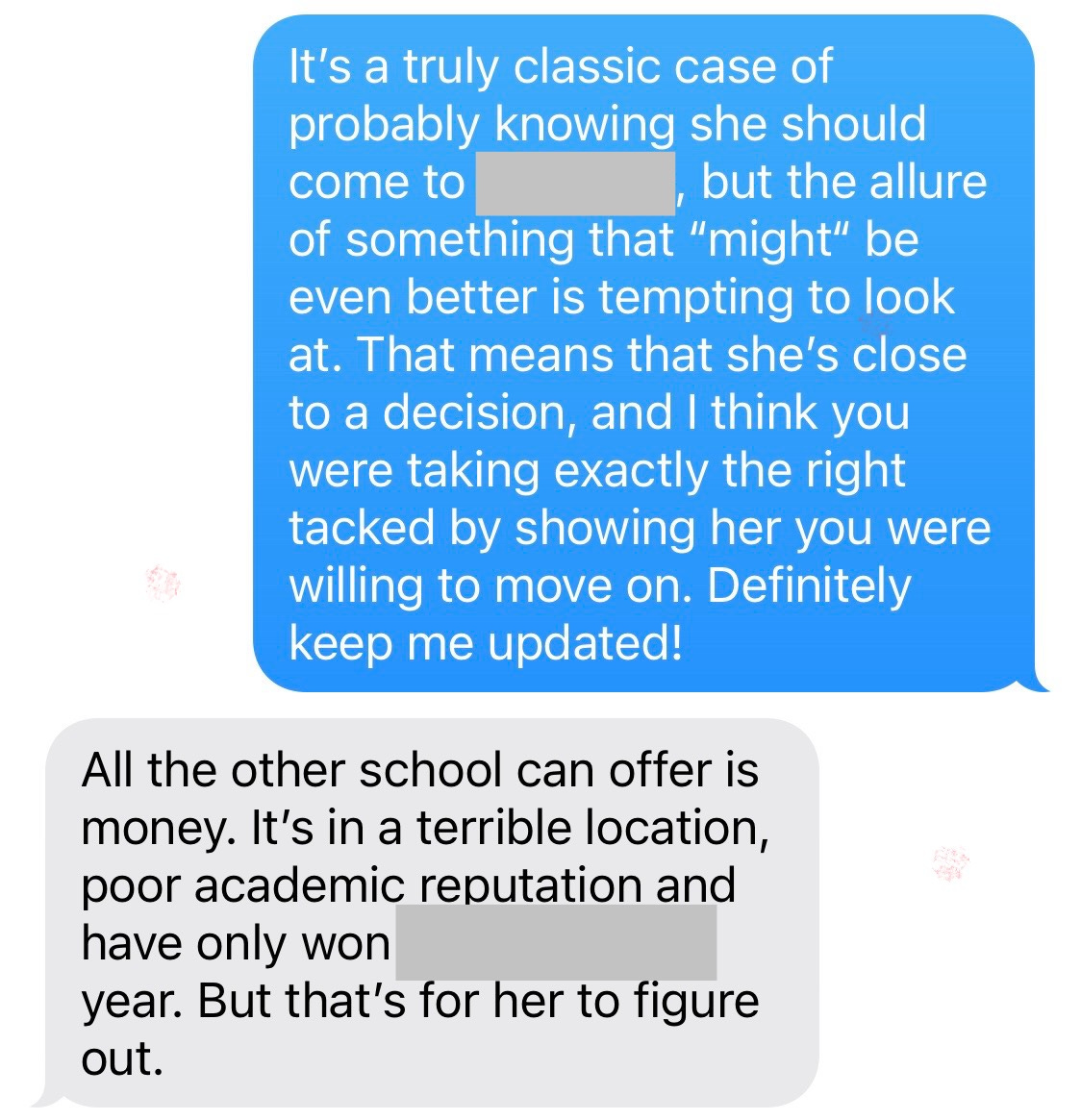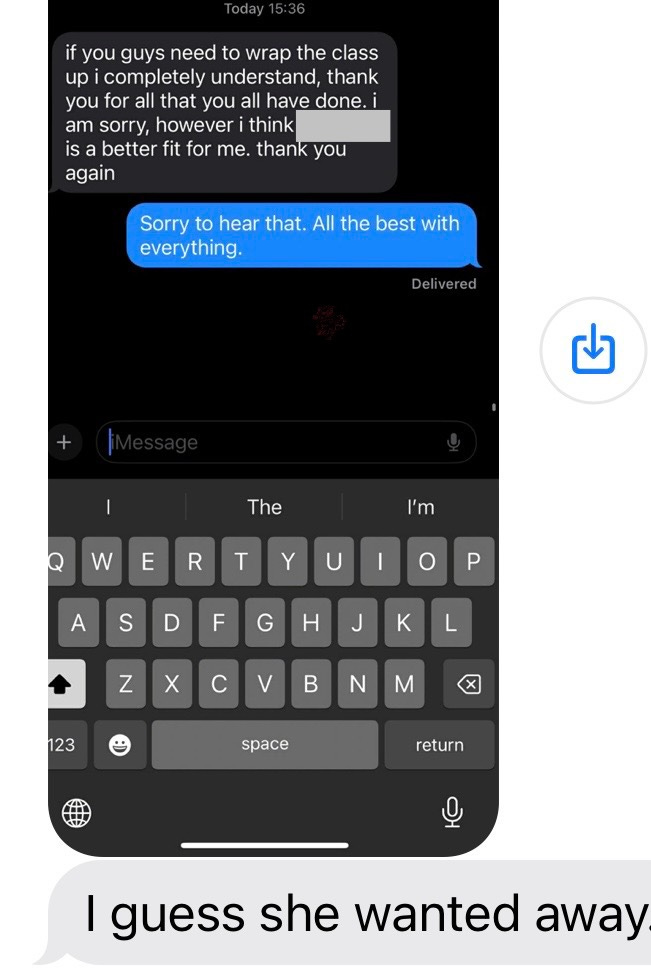You Tell Me: Is This Recruit Really Not Interested?
Or, is there something else going on? One coach wanted to know. Read our in-depth dissection of what the prospect said, how the coach responded, and the lesson is.
What do I and our staff do every day, day in and day out, for our clients?
This (among a long list of other things):
Clients will bring us into live recruiting conversations with their prospects, and have us help them not only craft the ‘right’ responses, but responses that actually move the process forward (or, help determine that they won’t get the prospect). We do this for Division I BCS-caliber programs, as well as small college programs. And, everything in between. It’s one of the things that’s the most fun to do in my day, if I’m being honest…I love to compete, and this is the scoreboard we use to log wins and losses.
So, what’s going on here:
At the start of the text exchange, the coach is having a normal conversation with the prospect about turning her test scores in. Normal part of the process later in the recruiting process, right?
Then, we get the dreaded “however”…followed by new information about another school that is showing interest. Translation: Coach, I’m dropping this hint because I think this is where I’ll end up going and I don’t want a confrontation with you, so I’m dropping a little oh-by-the-way on you to help lessen the blow.
The third paragraph is the reply from the coach that was not sent yet (that’s what he wanted me to evaluate for him and suggest changes, if any.
In his draft reply, I thought he came across a little upset and a little stern. Do I blame him? No. This prospect has been ‘back-and-forthing’ (© Dan Tudor 2023) him for months…she’s in, she’s out, she’s interested, she’s not. I don’t blame him for having that reaction. But, it’s in the middle of a tight recruiting game here, so I wanted to revise the language to draw out the conversation and find out what she’s really thinking and what’s really going on.
Here’s what my suggested reply was - see if you can spot the small tweaks to the approach:
I didn’t want her to come away with a feeling of finality; rather, I wanted to mix in a little disappointment on our end, coupled with some confusion. When you act confused, Coach, it helps get them to open up and explain themselves to you so you won’t be confused any more.
For those of you of a certain age, it’ll remind you of the TV detective show from the 1970’s, “Columbo”. He always seemed to be confused, but in reality, he was drawing in suspects’ trust so he could gather more information. There’s a whole psychological study of his approach that works in real life (like the recruiting situation you’re reading about now.)
From The Columbophile Blog:
“Columbo did not accuse those he was questioning. By taking the responsibility for his confusion, he disarmed the other person — who then would slowly feel comfortable telling him the things he needed to know to solve the crime. The Columbo Method is to present the facts that appear to conflict, give the person the benefit of the doubt, and then ask questions for clarification.”
A typical Columbo conversation with a prospect - er, I mean, ‘suspect’:
Columbo: Gee, I just can’t help thinking though, but…if I was in the hands of kidnappers, and my wife didn’t ask me if I was okay, uh…I’d think about that.
Agent Carlson: What’s your point, Lieutenant?
Columbo: Point? No, no, no point. Just that, uh… she’s a unique person.
Dr. Mark Collier: You know something, Lieutenant? You’re a marvelously deceptive man. You know, the way you get to the point without really getting to the point.
(In case you wondering about the redactions, I don’t want protect our client’s privacy, as well as some important details that could help identify the other school or the prospect we are trying to help close)
And as he was sending out the revised text, I made this teaching point that is important for any coach to remember when they are in the later stages of a decision with their prospect:
So, will be have an interested recruit?
He sent the text, and then we waited…
And we didn’t have to wait long:
What every coach dreads, right?
“I lost the prospect”. Or, maybe “Dan lost the prospect”.
Except that here’s what I was thinking at the time:
We have a prospect who is a good fit, who has stayed in the game communicating with the coach for a long time, and offered up this updated info instead of just going radio silent on him. To me, that’s the sign of a conflicted prospect who is a little lost and is searching for guidance.
But, she seemed resigned to the idea of having to walk away - to a school that the coach, remember, feels is exactly the wrong fit for this prospect based on her profile and family background.
So, maybe we actually lost her?…
More on that in a second. But I want you to read my feedback to the coach, with an observation that a lot of coaches skim past as they are interacting with text messages that recruits send them:
Well, well, well.
A reply to the reply. She didn’t have to do that, she got what she wanted, right? Ended the relationship with the coach, and ready to move on.
Nope.
She now offers up a reason for the change to the other school. And, she offers up a classic “I wish…” which is a sign that she wants the coach’s help, but doesn’t know how to do it.
We’re back in the game.
So, what started as a “sorry, I’m not interested, Coach” has turned into:
It depends on my ACT score.
Tell coach I can’t give him an answer yet.
I can give him a concrete answer in 2 weeks (so, her original answer wasn’t concrete afterall - and, she just gave herself and the coaches a self-imposed deadline!)
And, credit to the coach for keeping his reply short and sweet, and not needy and desperate.
My feedback after all that was this:
One note on being all over the place:
It’s very normal with this generation. It’s a hectic process, a stressful decision, and they aren’t often guided through the process by someone competent. So, let’s give them a little bit of a break.
(Plus, some are being coached on this seemingly disorganized strategy)
We’ll find out what happens after the two week point, but the important thing is that our client is still in the game. And, they’ve put themselves into a position of showing that they are really the school that cares about her, wants her, and is willing to work with her - but under their terms (with agreement from her via her self-imposed two week deadline).
So, what are the three key takeaways for coaches who want to duplicate this approach with their next hesitant recruit?
Keep reading with a 7-day free trial
Subscribe to Honey Badger Recruiting to keep reading this post and get 7 days of free access to the full post archives.












